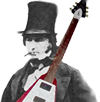Learning the Notes of the Fretboard

Fretboard map
How to Learn the Fretboard
After you have the basics down the first step in learning the fretboard is to memorize the notes along strings five and six. Focus on the natural notes (no flats or sharps). The natural notes are the letters A to G and always occur in alphabetical order. Some notes are one fret apart which is equal to the music distance of a half-step. Other notes are two frets apart which is equal to the music distance of a whole-step. Notes E and F along with B and C are right next to each other, always. This occurs on all strings wherever the notes are found.
Notes on Sixth String E
- The sixth string open is E. The next note is F (following the alphabetical order) and is at the first fret. When you play a common F chord your first finger is in the first fret. Use this association to help you remember the first fret is F.
- The next note is G (following the alphabetical order) and is at the third fret. When you play a common open G chord the root G is at the third fret of string six (that’s why you begin strumming there). Use this association to help you remember the third fret is G.
- Remember, in the alphabetical order only the notes A thru G are used. After G you go back to A. So, the next note on string six is A at the fifth fret. This note matches the open A string and is used for relative tuning.
- Finishing up you have B and C at frets seven and eight followed by D at fret ten. All the notes repeat starting with E at the twelfth fret, which is usually marked by a double dot.
- Memorize these notes and practice calling them out by name as you move forward and backward along string six..
Sharps and Flats
Once you’ve got the basic notes down you can fill in the gaps with sharps and flats. Sharp (#) means one fret higher while flat (b) means one fret lower (think, a flat tire is lower to the ground). So, the note at fret two is either F#, meaning one fret higher than F, or Gb, meaning one fret lower than G and so on up the neck..
Notes on Fifth String A
- The fifth string open is A, root of the open A chord.
- The second fret is B, root of the fairly common B7 chord.
- The third fret is C, root of the common open C chord.
- The fifth fret is D and matches the open D string.
- Finishing up you have E and F at frets seven and eight followed by G at fret ten. All the notes repeat starting with A at the twelfth fret.
- Memorize these notes and practice calling them out by name as you move forward and backward along the string..
